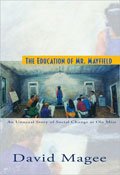At first glance, David Magee's "The Education of Mr. Mayfield" (John F. Blair, 2009, $21.95) gives the impression of a "Good Will Hunting" knock-off set in the rural South. Race replaces class, Ole Miss replaces Harvard, "Dixie" replaces Elliot Smith, and somewhere down the line we've got an "O Brother, Where Art Thou?" for Grove-tented book clubs.
Magee's M.B. Mayfield, however, comes across with little of the psychological complexity or character of his South Boston analogue, Will Hunting, although it's unclear as to whether this is a reflection of Mr. Mayfield the person (which I doubt), or a consequence of Magee's treatment of what seems to be an otherwise compelling story. Though Mayfield often finds himself at the schizophrenic intersection of black working class and white high society, in the text he is only barely self-aware of the conflicted and ambivalent reward of significant talent amidst the inertia of caste. Rather, Magee keeps him on the naïve side of aloof for most of the bookan "unassuming" and "almost apologetic" figure on a strange journey of history, race and class.
To best approach "The Education of Mr. Mayfield," a reader must jettison the notion that M. B. Mayfield֖a reclusive, mostly self-taught artist from Ecru, Miss.֖is the protagonist of this book bearing his name, or even that Stuart Purser֖then-chairman of the Ole Miss Art Department and Mayfield's unlikely teacher and patron֖shares the spotlight. Rather, over the course of the book a reader must watch Magee abandon the story of these two men in the interest of exploring the book's real main characters: an idyllic Oxford and (always by extension) its symbiotic foil, the University of Mississippi.
As a heavy-handed parable of the Jim Crow South, the book begins reasonably enough. Purser and Mayfield grow up in not-dissimilar settings: Purser on the white side of a Klan-dominated Louisiana mill town and Mayfield on the black side of a poverty-stricken hamlet in Mississippi Hill Country. Both men gravitate toward art as a means of escaping their situation.
While Purser is on a search for inspiration in the "less traveled roads of rural North Mississippi," he runs across a house adorned with a prominent bottle tree and large busts of Joe Louis and George Washington Carver. The house, of course, is Mayfield'swho is living there with his mother and had been creating art as a way to "channel his loneliness." Upon realizing Mayfield's talent, Purser devises a situation where he can informally instruct M.B., hiring him as a janitor and allowing Mayfield to listen to lectures, sometimes from the broom closet. Two months later, M.B. Mayfield's status at the periphery of both the Ole Miss classroom and Oxford art circles becomes a gentle challenge to the perils of segregation.
After Mayfield moves to Oxford, though, attempts at a meaningful relationship with Purser diverts into a larger-than-life Oxonian menagerie. Loyal Blind Jim Ivy, visionary Johnny Vaught, inscrutable William Faulkner, inflammatory Albin Krebs and even maverick James Meredith are all there in full caricature, and serve mostly as distractions for the rest of the book. While some inclusions are reasonable֖Faulkner befriends Purser and helps purchase art supplies for Mayfield֖it's never clear why Magee indulges the reader in the virtues of Vaught's "Split-T offensive formation."
Rather, these indulgences in Ole Miss nostalgia serve mainly to gloss over (or reinforce) unexplored assumptions about gender, sexuality and grammar. Above all, race gets superficial treatment. In the same vein as a tense trip to the Brooks Memorial Art Gallery in Memphis (a resolvable faux pas regarding segregated operating hours), the author rarely presents racial difference as much more than an anachronism or a nuisance of otherwise-redeemable heritage.
Over time, Purser grows professionally restless and dissatisfied with Ole Miss' unremitting segregation, eventually leaving to start yet another art department, and Mayfield remains relatively undiscovered but otherwise unruffled, eventually resettling in Ecru. What's left is a book "detailed in outline but scant in depth" (to borrow Mr. Magee's phrase about Mr. Mayfield's work), and glaringly uninterested in its own assumptions, outside the occasional right-thing-to-say about the evils of the Klan, the n-word, the logic of segregation, the assassination of Dr. King.
What is more, while it's self-described as "An Unusual Story of Social Change at Ole Miss," the book remains well within the bounds of the usual and the never-really-changing. It indulges so much in the noble premise of Stuart Purser's "discovery" of M.B. Mayfield's "primitive" art that it neither questions these terms nor explores their gaping corollaries. While Mayfield is limited to the promotion from janitor to security guard as his sole significant opportunity for job advancement, Purser seems to have the luxury to pack up and go create an art department somewhere else whenever he feels restless. This and many other situations in the book are racially and/or socioeconomically obvious. Instead of coming across as problematic, it comes across as quaint.
Ultimately, it is the comfort of the quaint and the pastoral that drowns out the best interest of David Magee's work, and through which a potentially humanizing and redeeming story barely survives as a kind of historical near-fiction, bloated with allegory and glistening in red and blue.



Comments
Use the comment form below to begin a discussion about this content.
comments powered by Disqus